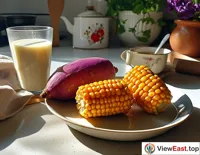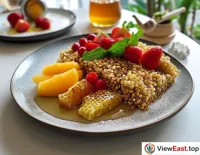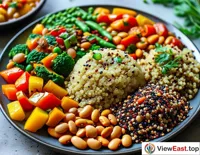







A: The Culture and Flavor Journey of Steamed Whole Grains
Amidst the trend of healthy eating, steamed whole grains have become a new favorite on modern dining tables for their unique nutrition and texture. They represent not only a return to a more natural diet but also a pursuit of a healthier lifestyle.
Cultural Background
Whole grains, including corn, sweet potatoes, brown rice, etc., have long been an essential part of human diets. With the modern emphasis on healthy eating, whole grains are highly regarded for their rich dietary fiber, vitamins, and minerals. Steaming is a healthy cooking method that preserves the original flavor and nutrition of the food.
Features and Taste
The specialty of steamed whole grains lies in their natural, healthy, and digestible nature. During the steaming process, the sweetness and aroma of the grains are retained, resulting in a soft and chewy texture. This cooking method is suitable for people with various tastes, from those who prefer the original flavor to those who seek adventurous flavors.
Appearance
The appearance of steamed whole grains is simple and unadorned, preserving the natural shape and color of the food. Corn is golden and tempting, sweet potatoes are soft and sweet, and brown rice is distinct and separate. Their colors and shapes add a touch of natural beauty to the dining table.
Nutritional Value
Whole grains are rich in dietary fiber, which helps promote intestinal movement and prevent constipation. They are also an important source of B vitamins, minerals, and antioxidants, greatly benefiting the maintenance of good health.
B: The Production Process of Steamed Whole Grains
Introduction of Ingredients
Common ingredients for steamed whole grains include corn, sweet potatoes, purple potatoes, brown rice, oats, millet, etc.
Production Tools
The tools required are a steamer, steaming trays, and a timer.
Ingredient Preparation
Clean the whole grains thoroughly to remove surface impurities.
Cut the grains into suitable sizes according to your needs, such as peeling corn kernels or cutting sweet potatoes into chunks.
Cooking Steps
Place the prepared whole grains into the steaming trays.
Put the trays into the steamer and start steaming.
Adjust the steaming time according to the type of grain until the ingredients are fully cooked.
Seasoning Techniques
Seasoning for steamed whole grains can be very simple, requiring just a pinch of salt or pepper. You can also add herbs or other seasonings according to personal taste, such as rosemary or thyme.
Consumption Suggestions
Steamed whole grains can be eaten alone as a staple food or paired with vegetables, meats, or bean products to increase nutritional and textural variety.